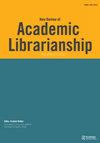Making Your Own Luck: Academic Libraries and the Digital Shift
IF 2.3
Q2 INFORMATION SCIENCE & LIBRARY SCIENCE
引用次数: 3
Abstract
Abstract COVID-19 did not disrupt higher education; it hastened the disruptions that have already been taking place. One particularly prominent disruption is the digital shift, or the move from primarily face-to-face operations to operations with a large digital component. In order to survive, higher education needs to fundamentally change. But how prepared is your library for these changes? You cannot simply wait for these changes to happen and hope to get lucky; instead, you need to make your own luck. Libraries are uniquely situated to lead the institution in this digital shift. This article will present an overview of student demographic and higher education trends such as decreasing enrollment, increasing diversity of the student body and its needs, technological disruptions, and changing workforce needs. Specific examples from two academic libraries in the United States will demonstrate how this information has informed practice, allowing these libraries to be ahead of the digital shift, to easily weather the COVID storm, and to be models for other campus departments. As humanity’s response to the COVID-19 crisis transitions from reactive to proactive, higher education cannot return to pre-pandemic operational norms. Libraries must position themselves to nimbly adjust to disruptions of traditional services rather than rely on “getting lucky” when change is forced upon them. Instead, make your own luck by intentionally integrating more digital resources into the collection and more virtual services into the workflow, using patron data to inform workflow decisions, and flexibly adapting crisis mode operations to sustainable, permanent operations. Ultimately, this article will show how librarians can combine the tried-and-true with new library practices to adjust to the digital shift in a way that positions them to lead campuses into the future of higher education.让自己的运气:高校图书馆与数字化转型
摘要新冠肺炎并未扰乱高等教育;它加速了已经发生的混乱。一个特别突出的颠覆是数字化转型,即从主要的面对面运营转向具有大型数字化组件的运营。为了生存,高等教育需要从根本上改变。但是你的图书馆对这些变化准备得如何呢?你不能简单地等待这些变化的发生并希望得到幸运;相反,你需要自己创造运气。图书馆处于独特的位置,能够在这一数字化转型中领导机构。本文将概述学生人口统计和高等教育趋势,如入学人数减少、学生群体及其需求的多样性增加、技术中断和劳动力需求的变化。来自美国两所大学图书馆的具体例子将展示这些信息如何为实践提供信息,使这些图书馆能够领先于数字化转型,轻松抵御新冠肺炎风暴,并成为其他校园部门的榜样。随着人类对新冠肺炎危机的反应从被动转变为主动,高等教育无法恢复到大流行前的操作规范。图书馆必须灵活地适应传统服务的中断,而不是在被迫改变时依靠“运气”。相反,通过有意地将更多的数字资源整合到收藏中,将更多的虚拟服务整合到工作流程中,使用客户数据为工作流程决策提供信息,并灵活地将危机模式的运营调整为可持续的永久运营,让你自己好运。最终,这篇文章将展示图书馆员如何将屡试不爽的做法与新的图书馆实践相结合,以适应数字化的转变,使他们能够带领校园走向高等教育的未来。
本文章由计算机程序翻译,如有差异,请以英文原文为准。
求助全文
约1分钟内获得全文
求助全文
来源期刊

New Review of Academic Librarianship
Social Sciences-Library and Information Sciences
CiteScore
3.40
自引率
0.00%
发文量
20
 求助内容:
求助内容: 应助结果提醒方式:
应助结果提醒方式:


